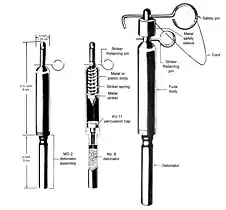| F-1 | |
|---|---|
 F-1 hand grenade | |
| Type | anti-personnel hand grenade |
| Place of origin | Soviet Union |
| Service history | |
| In service | 1939–present (Russia) |
| Used by | Soviet Union, Brazil, Cuba, China |
| Wars | World War II Hukbalahap Rebellion Korean War Vietnam War Rhodesian Bush War[1] Six-Day War Yom Kippur War Angolan Civil War Iran-Iraq War Iraq War 2011 Libyan Civil War Syrian Civil War War in Donbass 2022 Russian invasion of Ukraine |
| Specifications | |
| Mass | 600 g (1.3 lb) |
| Length | 130 mm (5.1 in) |
| Diameter | 55 mm (2.2 in) |
| Filling | Trinitrotoluene |
| Filling weight | 60 g (2.1 oz) |
Detonation mechanism | Time delay fuse 3.2 to 4.2 s |
_2.jpg.webp)

The Soviet F-1 hand grenade (Russian: Фугасный > Fugasnyy 1, "Explosive, Type #1"), is an anti-personnel fragmentation defensive grenade. It is based on the French F1 grenade and contains a 60 g (2.1 oz) explosive charge (TNT). The total weight of the grenade with the fuze is about 600 g (21 oz).
Due to its shape and its yellow-green color, it is nicknamed the limonka (fem. "little lemon"). It is also nicknamed Efka (Russian: Эфка) for the letter F.[2] It is similar to the American Mk 2 "pineapple grenade", which was also ultimately modeled on the French F-1.
Fuse
The Universal'nyi Zapal, Ruchnaya Granata, Modernizirovannyi]] (UZRGM) (Russian for "Universal Igniter, Hand Grenade, Improved") fuse is a universal Russian type also used in the RG-41, RG-42, RGO-78, RGN-86 and RGD-5 grenades. The standard time delay for this fuse is 3.5 to 4 seconds. However, UZRGM fuze variants are available which give delays between zero (i.e., instantaneous, specifically for use in booby-traps) and 13 seconds. It is possible to hear a loud "pop" as the fuse ignites and begins to burn.
History
The F-1 was introduced during World War II and subsequently redesigned post-war. It has a steel exterior that is notched to facilitate fragmentation upon detonation and to prevent hands from slipping. The distance the grenade can be thrown is estimated at 30–45 m (98–148 ft). The radius of the fragment dispersion is up to 200 m (660 ft) (effective radius is about 30 m (98 ft),[3]). Hence, the grenade has to be deployed from a defensive position to avoid self-harm. About 60 percent of the grenade body pulverizes during the explosion, only 30 percent of the body splits into 290 high-velocity, sharp-edged splinters each weighing around 1 gram with an initial speed of about 700 m/s (2,300 ft/s).
Foreign copies
The F-1 grenade has been supplied to various Soviet allies and Third World nations over the years, including Iraq and other Arab nations, and there are different production variations according to country of origin (in terms of finish, markings and spoon/lever design). Though obsolete and no longer in production, it can still be encountered in combat zones. A copy of this grenade, dubbed the RGG-91 has been manufactured between 1992-1996 in Lithuania, by small arms factory "Vytis".
 People's Republic of China: Type 1 Grenade.
People's Republic of China: Type 1 Grenade. Lithuania: RGG-91
Lithuania: RGG-91